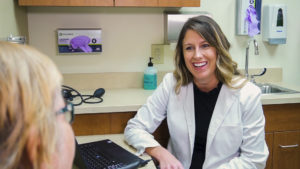
Things don’t work that way in a private medical practice, a fixed-income business. If the costs associated with practicing medicine increase, physicians are still beholden to medical codes and the whims of payers, who set the rates. Most private practices are left scrambling trying to balance the demands of staffing and other expenses. Invariably, physician income suffers.
Fortunately, when I became a physician and joined a practice that eventually became Internal Medicine Associates of Reston, my business experience paid off when it came to negotiating mutually beneficial rates with payers. We were aggressive, often opting out of contracts until payers came back to us with more favorable terms. Our experience was the exception, however, not the rule.
Despite our success in negotiating with payers, my colleagues and I noticed that expectations in medicine were changing, requiring levels of technology and care coordination that we couldn’t provide on our own. It’s no longer acceptable to run a practice by just focusing on your patients as they sit in front of you. As the healthcare industry moves to value-based care, and patients trend toward consumerism, it’s important to incorporate the principles of population health. This requires actively monitoring and participating in the care your patients receive outside of the office.
Now, more than ever, primary care physicians have to take responsibility for the overall care of our patients.
Medicare and commercial payers are moving to systems of monitoring quality, performance, and cost savings, and are paying providers according to the overall value they provide to their population of patients. Silos of independent practices, whatever their size, will not be able to meet the performance metrics that will be required by payers over time.
Healthcare’s shift leaves primary care physicians in a bit of a pickle. How do we maintain independence and also prepare for changing paradigms in healthcare? Not only is the system moving to value, but value and population health are measured differently by different players in the system, and practices need to be nimble to accommodate variability. For example, at our practice, while Medicare follows the rates of our Annual Wellness Visits, another private payer puts an emphasis on our diabetic eye exams and may not care about the routine physicals we perform on our other patients. Totally independent practices just aren’t equipped to handle the capriciousness in the system.
I don’t recommend selling one’s practice to join a large health system, unless you would like to forego all semblance of independence. In those systems, your productivity and hiring decisions are controlled by your employer. Furthermore, studies show that they rarely improve outcomes; for example, most hospital-based ACOs don’t generate shared savings, nor are able to move as nimbly as other configurations of independent practices.
How did Internal Medicine Associates of Reston come to terms with healthcare’s change? We were lucky to find a group of like-minded physicians who were dedicated to the goal of improving health care while wanting to maintain maximum independence, as well as a management team that approached us with a win-win attitude. While our practice had its successes in the old world of fee-for-service (we were constantly in the top 5 percent of income for primary care doctors) it was time to evolve and future-proof our practice.
My recommendation? If you’re a small, mid-sized, or even large private practice, explore your options for alignment. With our current configuration, Internal Medicine Associates of Reston is in a good position to overcome the seemingly unscalable wall of fixed income because our medical group invests significantly in population health. By preparing for healthcare’s shift, your mom-and-pop businesses of medicine will be ready participate in value-based contracts, and you can continue to run your businesses the way you see fit, well into the foreseeable future.
















I enjoyed this read . It gave me a morale boost! I also enjoyed Dr. Taweel’s perspective.